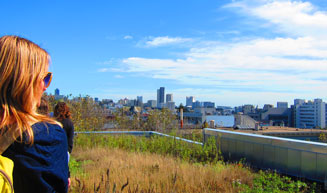

Contributor
- Topics: Archive
There is more to green roofs than meets the eye. Like terrestrial gardens, green roofs come in all shapes and sizes, with myriad designs and methodologies depending on their intended purpose. It’s time to look deeper into tapping their potential to create greener and more livable cities.
A conversation between Editor Lorene Edwards Forkner and Kay Cheng, Urban Designer/Planner, City and County of San Francisco

LEF: What are your thoughts on developing a green roof policy for San Francisco?
KC: I’ve recently realized the potential for green roofs to work for a variety of building types and at different scales to achieve a multitude of benefits. An important lesson I learned on the Swiss tour is that green roofs don’t have to be complicated or require highly technical systems. (For more on this topic see page 28.) I’d like to see a series of local pilot projects and a robust research effort lead the way to regulation similar to Zurich where all flat roofs are green roofs.
LEF: From a municipal perspective, what benefits do green roofs provide?
KC: Green roofs offer buildings the chance to give back. First of all they’re beautifuland they connect people to nature within an urban environment. This is especially important for those with limited mobility issues who may have a hard time getting out of the city. Another great benefit of green roofs and walls is their ability to be installed in dense urban environments that lack space to accommodate other types of traditional street tree and sidewalk garden greening. Green roofs help mitigate the heat island effect of concrete and retain stormwater run off. They also provide habitat and promote biodiversity, which helps to reduce the ecological footprint of development

LEF: How do you see a green roof policy integrating with other greening efforts to create a vibrant living matrix within your city?
KC: Green roof policy directly ties into a number of other efforts already at work in San Francisco. These include: Green Connections, Eco Districts, Biodiversity Strategy, Stormwater Design Guidelines, as well as the Green Building Code, Sidewalk Landscaping, Urban Agriculture, and the Urban Forest Plan. I’d like to see San Francisco build upon the objectives I authored in my Urban Forest Master Plan to fully realize an urban forest—complete with trees, walls, and roofs—by developing an interagency “Better Roofs and Walls” strategy similar to the already successful Better Streets Plan.
In addition to supporting elected officials, we need to empower people. We need champions—individuals and organizations—to push this agenda and put pressure on the utility company and other city agencies not yet convinced of the need to create a coordinated policy. Many believe green roofs have a singular value. We need to change that attitude and promote a bigger picture of the many benefits they provide.
LEF: What’s next? How can readers in San Francisco—and beyond—get involved?
[sidebar]Resources:
Green Roof Alliance collaborates with industry professionals and communities to promote healthy and sustainable green roofs in California. www.greenroofalliance.com
CitiesAlive: Green Roof & Wall Conference, San Francisco, October 23–26, 2013. www.citiesalive.org
Green Roofs Healthy Cities is a not-for-profit industry association working to promote green roofs throughout North America: www.greenroofs.org
San Francisco Urban Forest Plan: www.sf-planning.org, search: Urban Forest Plan
SPUR (San Francisco Planning and UrbanResearch): www.spur.org[/sidebar]
KC: This is an opportune moment to craft a San Francisco green roof policy with a great deal of local momentum surrounding the CitiesAlive conference coming up in late October. Leaders and designers from throughout the green roof industry will be gathering in the Bay Area, providing an opportunity to gather feedback and solicit advice on how to proceed with a policy plan.
On an individual basis, Green Roof Alliance has a page on their website mapping existing green roofs through- out the Bay Area; this information allows us to better understandperformance and potential research spots. Even people beyond this area can enter data on green roofs in their region on the GrowingMap website where they say: “Sharing your locations is another way to participate in this global effort to bring a growing change.”
And hopefully all this will inspire folks to install a green roof on their house or workplace!









Responses